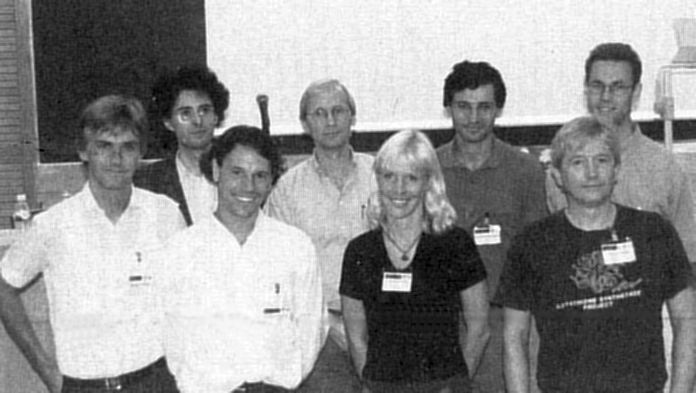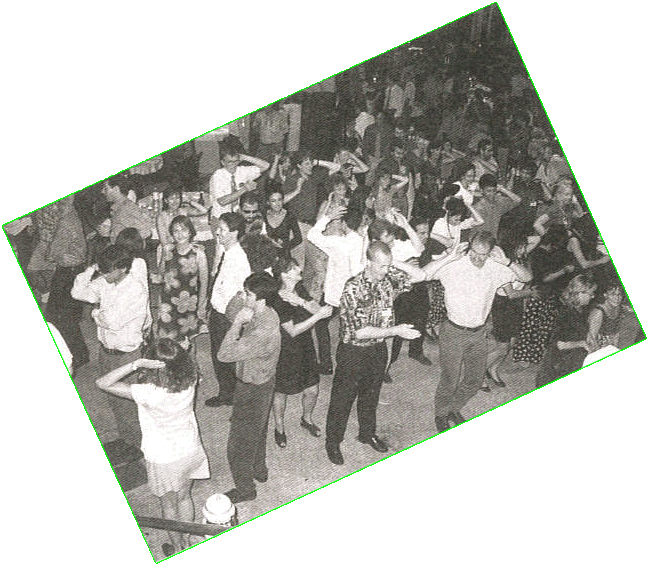
Meeting report
ECM-17 Lisbon - fast forward
 Speakers at the microsymposium on Time Resolved Crystallography. Frontrow (left to right): M. Wulff, R. Neutze, H. Kack and J. Hajdu, back row: F. Schotte, E. Weckert, D. Bourgeois and T. Ursby. (Photo W. L. Duax)
Speakers at the microsymposium on Time Resolved Crystallography. Frontrow (left to right): M. Wulff, R. Neutze, H. Kack and J. Hajdu, back row: F. Schotte, E. Weckert, D. Bourgeois and T. Ursby. (Photo W. L. Duax)
Time resolved studies made possible by synchrotron radiation were a popular topic at the 17th European Crystallographic Meeting in Lisbon. In his opening lecture, P. Coppens described in situ studies of small molecule reactions and detailed analysis of electron density distribution in reaction intermediates. A session devoted to studies of protein dynamics included detailed examination of the steps of biotin formation (H. Kack, Sweden), the movement of Fe ions toward the heme plane in hemoglobin nanoseconds after an excitatory laser flash (T. Ursby, ESRF, France), the do's and don'ts of effective Laue technology (D. Bourgeoise, Grenoble), and stroboscopic diffraction from a specific step in the photocycle of bacteriorhodopsin (F. Schatte, ESRF). These presentations were just a warm up for the real fireworks when R. Neutze decribed using a combination of X-ray and laser pulses to generate a wave front reaction path through a crystal that is captured in the diffraction image so that the texture of the wave can be observed and the underlying reaction elucidated. Just as a "Mexican wave" can be seen to pass across a cheering section so a change in structure can be seen to move across a single crystal. For the time being the best candidates for application of this technique are inorganic structures with small unit cells. This Brilliant Session on Brilliant Sources moved from today's state of the art use of synchrotron facilities to the future exemplified by E. Weckerts discussion of diffraction without crystals. He hopes to study the structure of small molecular clusters with X-ray free electron laser diffraction from a single molecule of a rhinovirus or a small cluster of molecules. A discussion of the smallest usable crystal and the relative merit of X-ray versus electron diffraction closed the session.
A session devoted to studies of protein dynamics included detailed examination of the steps of biotin formation (H. Kack, Sweden), the movement of Fe ions toward the heme plane in hemoglobin nanoseconds after an excitatory laser flash (T. Ursby, ESRF, France), the do's and don'ts of effective Laue technology (D. Bourgeoise, Grenoble), and stroboscopic diffraction from a specific step in the photocycle of bacteriorhodopsin (F. Schatte, ESRF). These presentations were just a warm up for the real fireworks when R. Neutze decribed using a combination of X-ray and laser pulses to generate a wave front reaction path through a crystal that is captured in the diffraction image so that the texture of the wave can be observed and the underlying reaction elucidated. Just as a "Mexican wave" can be seen to pass across a cheering section so a change in structure can be seen to move across a single crystal. For the time being the best candidates for application of this technique are inorganic structures with small unit cells. This Brilliant Session on Brilliant Sources moved from today's state of the art use of synchrotron facilities to the future exemplified by E. Weckerts discussion of diffraction without crystals. He hopes to study the structure of small molecular clusters with X-ray free electron laser diffraction from a single molecule of a rhinovirus or a small cluster of molecules. A discussion of the smallest usable crystal and the relative merit of X-ray versus electron diffraction closed the session.



